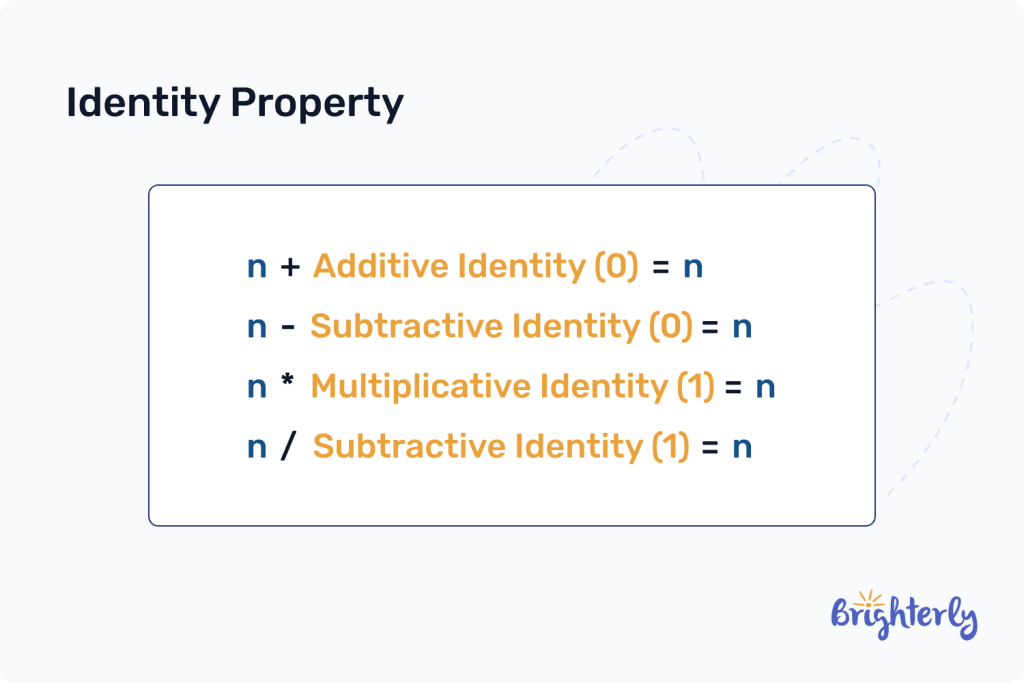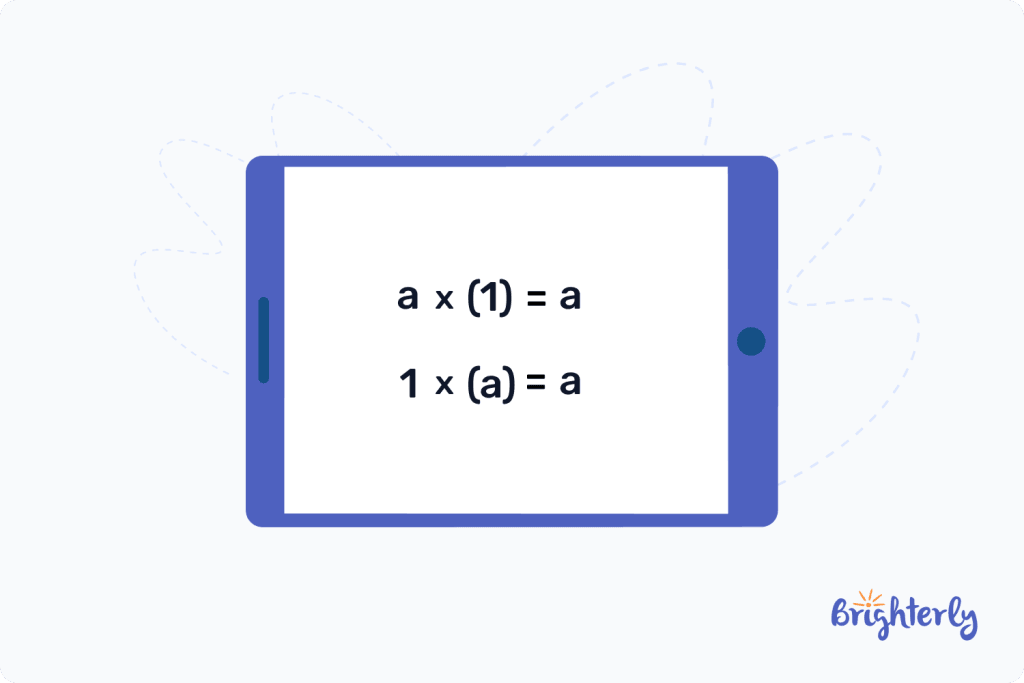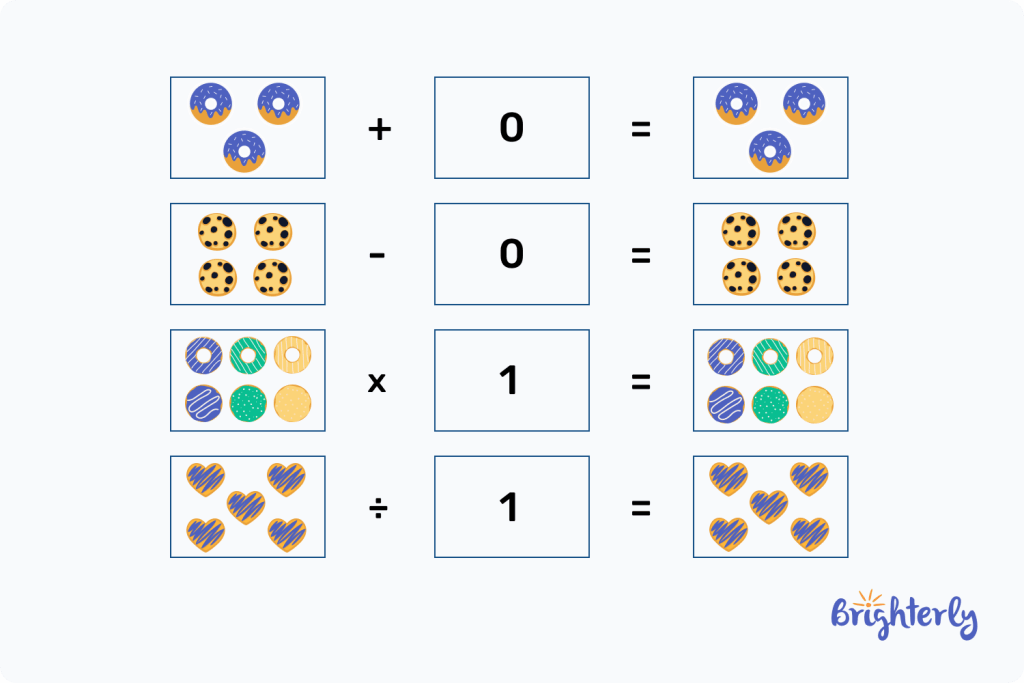Identity Property of Multiplication – Definition With Examples
reviewed by Jo-ann Caballes
Updated on December 11, 2024
Welcome to Brighterly, where we demystify math and take you on an engaging journey through your education.
Today, we’re going to cover the identity property of multiplication, a key rule in the world of multiplication.
Here, we’ll cover the definition of identity property of multiplication, the role of the number 1 player, example of identity property of multiplication and more. We’ll also share practice test questions and worksheets so you can continue your learning!
What is identity property?
Identity property is a rule that applies to the four operations of mathematics – addition, subtraction, multiplication and division. It states that a number can be added to, subtracted from, multiplied by or divided and still remain that number. For addition and subtraction, we’d use 0 to keep the number the same, and for multiplication and division, we use 1.

What is the identity property of multiplication?
The identity property of multiplication is a branch of identity property that relates to multiplication. It states how a number can remain the same in a multiplication operation. We cover the full definition below.
Identity property of multiplication definition
The definition of the identity property of multiplication is a rule that states any number multiplied by 1 will remain at the same value. The number won’t change in this equation.

Examples illustrating the identity property of multiplication
Here are some identity property of multiplication examples:
- 1 x 1 = 1
- 2 x 2 = 2
- 3 x 3 = 3
- 4 x 4 = 4
- 5 x 5 = 5
- 6 x 6 = 6
- 7 x 7 = 7
- 8 x 8 = 8
- 9 x 9 = 9
- 10 x 10 = 10
Exploring the identity property
Identity property is a fundamental property in math that explains how some numbers can remain the same even when combined with different operations.
Concept of ‘identity’ in mathematics
In mathematics, identity is an equation that will always be true, no matter what values we have in it. There are different types of identities in math:
- Algebraic
- Trigonometric
- Exponential
- Logarithmic
- Hyperbolic
Number one in the identity property
The number 1 is key to the identity property. The identity property of 1 states that any number multiplied by 1 will remain the same value. This is another name for the identity property of multiplication.
Properties of the identity property of multiplication
The key property of the identity property of multiplication is that any number multiplied by 1 will remain as that number. It has further characteristics that we’ll dive into.
Characteristics of the identity property
One of the key characteristics of the identity property is that it doesn’t just apply to whole numbers. It can also apply to decimals, fractions and minus numbers. It also has characteristics of the additive identity property, which states numbers will remain the same if 0 is added to them, as well as the identity element of multiplication.
Demonstration of the identity property
To help with your understanding of identity property, it’s best to see it demonstrated. Here, we’ll give some demonstrations.
Visual representation of the identity property
We can visually represent the identity property by using objects to illustrate how it works. For example, below we have used a number of objects as part of visual equations that represent the identity property:

You can see here that the number of all the items remains the same.
Examples of the identity property
Here are some examples of identity property:
- 9.4 + 0 = 9.4
- ¼ – 0 = ¼
- -125 x 1 = -125
- 18 ÷ 1 = 18
In all of these equations, we can see that the number remains the same. It also demonstrates that we can use this with decimal numbers, fractions and minus numbers too. This is evidence of identity property.
Practice problems demonstrating the identity property
Solved math tasks: examples
Ready to put your knowledge on the multiplication identity to the test? Try our solved math problems, then check your answers at the end to ensure they are correct!
Solved math task 1
Which equation illustrates the identity property of multiplication?
- 9 x 6 = 54
- 16 x 10 = 160
- 45 x 1 = 45
Answer:
| 45 x 1 = 45. |
This demonstrates the multiplication identity property because the number remains the same after being multiplied by 1.
Solved math task 2
Which equation shows the identity property of multiplication?
- 12 x 5 = 60
- 150 x 2 = 300
- 329 x 1 = 329
Answer:
| 329 x 1 = 329. |
Solved math task 3
Which equation demonstrates the multiplicative identity property?
- -2084 x 1 = -2084
- ¼ x 2 = ²⁄₄
- 25 x 3 = 75
Answer:
| -2084 x 1 = -2084. |
Frequently asked questions on the identity property of multiplication
Does the identity property apply only to whole numbers?
No, the identity property does not only apply to whole numbers. We can also use the identity property with minus numbers, fractions and decimal numbers. No matter the type of number, the identity property will always remain true.
Why is the number one considered the identity element in multiplication?
The number one is considered the identity element in multiplication because it is the only number another number can be multiplied by and remain the same. This means it reflects the identity principle in math, because the number’s identity has not changed.
How does understanding the identity property help in learning math?
The identity property helps in learning math by showing us that even when numbers are multiplied, divided, added to or taken away from, they can sometimes remain the same. It’s a foundational concept that can help kids in their understanding of key math operations and concepts including addition, subtraction, multiplication, division, algebra, trigonometry and more.
Identity property of multiplication: recommended worksheets
Our fun, free math worksheets help you to improve your knowledge on the identity property multiplication even further. Download our worksheets today:






